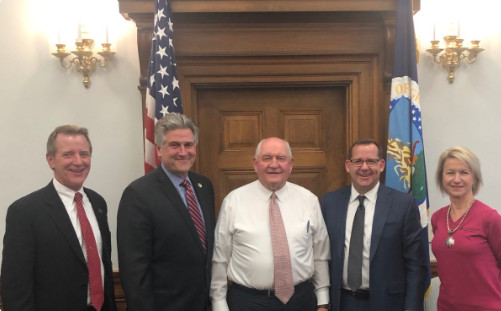
Weather. Markets. Policy. Agriculture is defined by cycles that exist beyond the control of the individual. And farmers have been working through those cycles for generations. Thankfully, they understand them. Thankfully, most keep returning to the fields despite what is thrown at them.
Currently, farmers face a multitude of overlapping hurdles that range from international trade wars, a partial government shutdown, multiple years of low commodity prices and consecutive natural disasters. What does this mean for the farm economy? What about the health of our rural communities? To help policymakers understand the landscape, three Farm Credit CEOs came to Washington, D.C., to offer an on-the-ground perspective.
Kathy Heustess, CEO of ArborOne Farm Credit (ArborOne), Mark Jensen, CEO of Farm Credit Services of America/Frontier Farm Credit (FCSAmerica/Frontier), and Marc Knisely, CEO of AgCountry Farm Credit Services (AgCountry) met with United States Department of Agriculture (USDA) Secretary Perdue, White House National Economic Council staff, the House and Senate Agriculture Committees, farm/commodity organizations and the Ag trade press to provide an update on the challenges facing farmers today.
Fortunately for those of us who like to eat three meals a day, most farm operations will likely weather these current storms – but that doesn’t mean 2019 will be free from challenges.
Representing South Carolina, which has dealt with devastating natural disasters each of the past four years, as well as the Grain Belt states, which have been hit hardest by recent low commodity prices, Kathy, Mark and Marc provided insight into the lives and finances of their customers.
In an illustrative analogy, Marc compared the current situation in agriculture to an inverted iceberg. “The tip of the iceberg is a little bit below water, but most of it is still afloat. We have some people who are going through some very severe economic times, and it won’t take much to push that iceberg a little further in the water and cover up more operations,” he said. As farmers face increasing impediments, Farm Credit calls upon a variety of tools to keep that “iceberg” as high above water as possible.
One such tool is patronage. As a cooperative, Farm Credit institutions only use the profits they generate in two ways. They retain a portion to build and retain financial strength, and they return a portion back to their customer-owners, typically in the form of a cash payment.
Many Farm Credit associations, understanding the recent economic hardship farmers and ranchers are experiencing, have leaned on that financial strength to pay larger and earlier patronages to customers in 2018 than in years past. For example, AgCountry returned $34.5 million to customers in 2017 and has announced that it will return $42.5 million as 2018 dividends, a marked increase from last year and the largest amount to date.
Another resource that Farm Credit associations have made available to customers is the increased support of “relationship managers” – staff who provide personalized, hands-on assistance to customers. “Relationship managers don’t sit behind a desk 24/7. They are in a vehicle, fit with a computer and a cellphone, and they’re out closing loans on the hoods of pickup trucks. The real value is the relationship that they build with farmers. If a problem is on the horizon, they’ll know about it earlier and be able to help quicker,” said Kathy.
Take, for example, FCSAmerica/Frontier customers Joe and Lisa, a young couple who bought their family farm in 2011. When they started farming, commodity prices were high and their income was strong. Once prices started falling, Joe and Lisa turned to Farm Credit for support. Together with their newly assigned relationship manager, Joe and Lisa prepared a detailed budget and breakeven analysis that allowed them to streamline their operation and cut costs. They sold unnecessary equipment and Farm Credit helped them to re-amortize debt payments. As a result, Joe and Lisa broke even the next year, and even turned a small profit the following year.
While producers face mounting barriers from factors beyond their control, Farm Credit is dedicated to remaining reliable and supportive as farmers work through this challenging time. From patronage payments to personalized financial guidance, Farm Credit employees across the country labor day-in and day-out to provide farmers with the best support possible.
